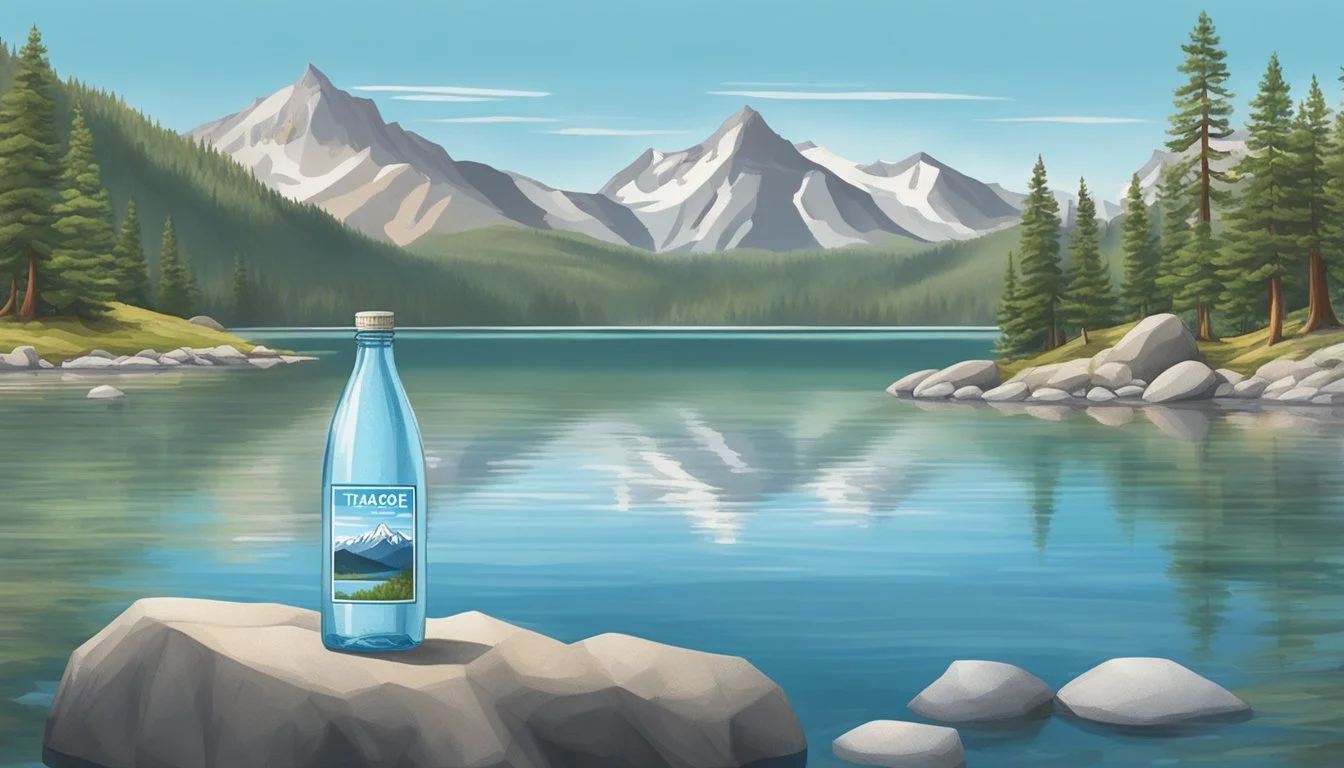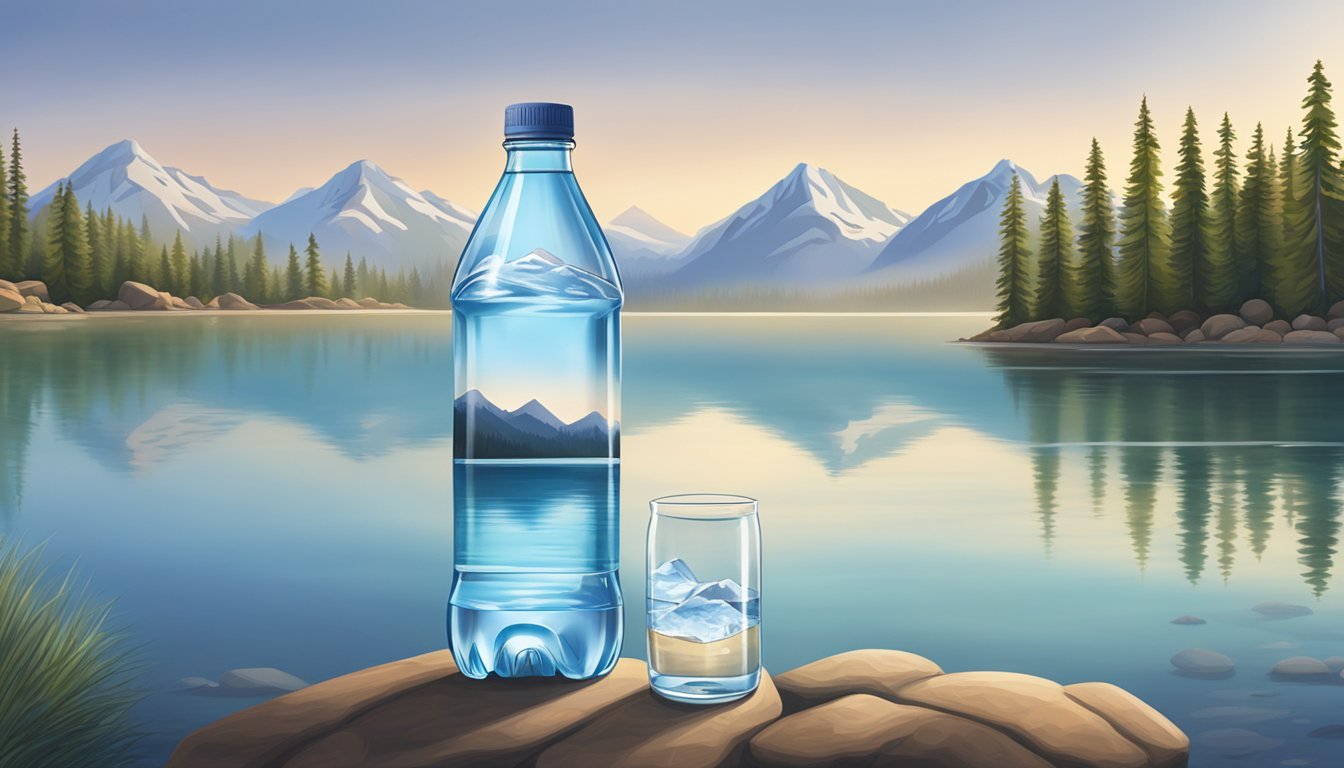Tahoe vs. Crystal Lake
Comparing Two Premium Bottled Waters
Choosing the best bottled water can be challenging with so many options on the market. Among the premium brands, Tahoe and Crystal Lake are often compared by consumers. Tahoe is renowned for its crisp taste and high mineral content.
On the other hand, Crystal Lake boasts an ultra-pure profile with its meticulous filtration process. Both brands offer unique qualities that cater to different preferences.
Understanding the distinctions between these two can help you make an informed decision. Whether you prioritize taste, purity, or mineral content, this comparison will highlight which water might be the best fit for your needs.
Understanding Bottled Water
Bottled water comes in various types, each catering to different preferences and health needs. These types include spring water, purified water, mineral water, and alkaline water.
Spring Water
Spring water is derived from natural springs and undergoes minimal processing. It contains natural minerals that can be beneficial for health.
Purified Water
Purified water is water that has been filtered or processed to remove impurities and contaminants. Methods include distillation, deionization, and reverse osmosis.
Mineral Water
Mineral water naturally contains minerals like calcium, magnesium, and potassium. These essential minerals can offer health benefits, including improved hydration and electrolyte balance.
Alkaline Water
Alkaline water has a higher pH level than regular tap water. It is believed to help neutralize acid in the body, though scientific evidence supporting these claims is limited.
Tap Water
Tap water is the water supplied to homes and businesses by local municipalities. While generally safe to drink, its quality can vary depending on the local water source.
Health and Hydration
Hydration is crucial for overall health. Bottled water provides a convenient source of hydration, often free from contaminants found in some tap water sources.
pH Levels: The pH of water can affect its taste and potential health benefits.
Minerals and Electrolytes: These are essential for various bodily functions, including muscle contractions and nerve signaling.
In summary, understanding the different types of bottled water can help individuals make informed choices that best suit their hydration needs and health preferences.
Analyzing Water Quality
Analyzing the water quality of Tahoe and Crystal Lake involves looking at aspects such as pH balance, mineral content, safety standards, and taste profile. These factors help determine which brand offers superior hydration and health benefits.
PH Balance and Mineral Content
The pH balance of bottled water influences its taste and potential health benefits. Tahoe generally maintains a pH level of around 7.5, making it slightly alkaline. Crystal Lake, on the other hand, has a pH of approximately 7.0, which is neutral.
Mineral content is another important factor. Tahoe water is rich in minerals like calcium and magnesium, contributing to its crisp taste and potential health perks. Crystal Lake contains fewer minerals, leading to a cleaner but less distinct flavor.
Comparing these two, Tahoe's higher mineral content and slightly alkaline pH may appeal to those seeking more nutrients and a bolder taste.
Safety Standards and Regulations
Both Tahoe and Crystal Lake adhere to stringent safety standards set by the FDA and EPA. These regulations ensure that bottled water is free from harmful contaminants, such as lead, and meets specific health guidelines.
Tahoe water undergoes rigorous testing to verify that it meets or exceeds safety requirements, with regular checks for contaminants like bacteria and heavy metals. Crystal Lake also follows similar safety protocols, ensuring consumer safety.
Despite these precautions, studies have occasionally found trace contaminants in both brands. Regular testing helps keep these levels well within safe limits, maintaining trust in the products.
Comparative Taste Profile
Taste is a subjective yet crucial factor in choosing bottled water. Tahoe water is often described as having a crisp, slightly mineral-like taste due to its higher mineral content. This profile is appealing to those who enjoy a distinct flavor in their water.
Crystal Lake is noted for its clean and neutral taste, attributed to its balanced pH and lower mineral concentration. This makes it a preferred choice for people who prefer a more subtle water flavor.
The variation in taste profiles highlights the importance of personal preference when selecting between the two brands. Crystal Lake's neutral taste contrasts with Tahoe's bolder mineral flavor, offering options for different palates.
Major Bottled Water Brands
This section highlights the leading bottled water brands, delving into their market offers and undertaking a comparative analysis of Tahoe and Crystal Lake.
Market Leaders and Their Offers
The bottled water market features a variety of well-known brands, each with unique characteristics. Dasani and Aquafina are popular due to widespread availability and affordability. Both brands utilize municipal sources, making them convenient options.
Evian and Fiji emphasize purity and mineral content, sourced from natural springs and artesian aquifers, respectively. Smartwater stands out for its vapor-distilled process and added electrolytes, catering to those seeking enhanced hydration.
Essentia focuses on ionized alkaline water, delivering a pH of 9.5. Voss and Acqua Panna boast premium packaging and natural sources, appealing to luxury consumers. Meanwhile, Nestlé Pure Life and Poland Spring offer reliable, everyday hydration options.
Other notable brands include Core Hydration, Arrowhead, Mountain Valley, Icelandic Glacial, Zephyrhills, Crystal Geyser, LifeWTR, and Boxed Water, each providing distinct benefits and unique hydration experiences.
Brands Comparison: Tahoe vs. Crystal Lake
Tahoe and Crystal Lake are two emerging names in the bottled water market. Tahoe presents itself with a focus on natural purity, sourcing water from protected mountain springs. It promises a clean taste with naturally occurring minerals.
Crystal Lake, contrastingly, emphasizes purity achieved through advanced filtration techniques. The brand claims this results in a contaminant-free product ideal for health-conscious consumers.
When comparing, Tahoe's appeal lies in its commitment to sustainable sourcing, often highlighted by its eco-friendly initiatives. Crystal Lake stands out for its meticulous filtration process, ensuring high safety standards.
Both brands target different consumer bases. Tahoe's emphasis on natural spring water resonates with those seeking unprocessed hydration. Crystal Lake attracts those prioritizing advanced purification. Each offers a unique hydration experience shaped by their sourcing and processing methodologies.
Source and Purification Processes
Tahoe and Crystal Lake employ distinct methods for sourcing and purifying their water. Tahoe emphasizes a natural approach, while Crystal Lake focuses on advanced purification techniques to ensure high purity levels.
Natural Spring Water vs. Purified Water
Tahoe sources its water from natural springs. This type of water is generally prized for its natural mineral content. Collected directly from springs, it undergoes minimal processing to retain its natural properties.
Crystal Lake, on the other hand, uses purified water. This water goes through extensive purification processes, significantly reducing contaminants and additives. Purified water often starts as municipal tap water but is treated to meet stringent quality standards, making it suitable for consumption.
Brand Water Source Mineral Content Tahoe Natural Spring Water High Crystal Lake Purified Water Low
Filtration and Purification Techniques
Crystal Lake employs advanced purification techniques, including reverse osmosis and UV light treatment. Reverse osmosis forces water through a semi-permeable membrane, removing most contaminants. UV light treatment disinfects the water, ensuring it is free of harmful microorganisms.
Tahoe's water undergoes minimal filtration to preserve its natural mineral content. This process typically involves sediment filtration and carbon filtering to remove larger particles and chlorine. Tahoe values maintaining the water's natural qualities while ensuring it is safe to drink.
These approaches highlight the brands' priorities—Tahoe focuses on natural purity, whereas Crystal Lake emphasizes modern purification techniques. Each method offers unique benefits tailored to different consumer preferences.
The Business of Bottled Water
The bottled water industry is a significant economic player with major companies and substantial impacts. Ethical considerations and corporate responsibility are crucial in this sector.
Industry Players and Economic Impact
This industry involves numerous well-known companies, with Coca-Cola and Nestlé among the leaders. Coca-Cola's Dasani and Nestlé's Poland Spring are prominent brands dominating the market. The International Bottled Water Association (IBWA) supports these companies through advocacy and regulatory compliance efforts.
The economic impact is substantial, involving billions in revenue annually. These companies invest heavily in marketing and distribution, contributing to local economies through job creation and infrastructure development. Bottled water sales surged in recent years, partly due to increasing demand for convenient and perceived cleaner alternatives to tap water.
Ethical Considerations and Corporate Responsibility
Ethical considerations in the bottled water industry focus on environmental impact and corporate practices. Companies face scrutiny over plastic waste, with significant pressure to adopt sustainable packaging. Nestlé and Coca-Cola have initiated efforts to reduce plastic usage and increase recycling rates.
Corporate responsibility extends beyond environmental concerns. Companies are expected to ensure fair labor practices and transparent sourcing methods. The Environmental Protection Agency (EPA) sets water quality standards, which companies must meet or exceed. Brands like Crystal Lake and Acqua Pana are analyzed not only for taste but for their adherence to ethical and sustainable practices, influencing consumer trust and loyalty.
Environmental Impacts and Sustainability
Both Tahoe and Crystal Lake bottled water brands emphasize sustainability and environmental protection, each with unique approaches.
Tahoe sources its water from groundwater near Lake Tahoe, managed for environmental sustainability. South Lake Tahoe plans to implement a single-use plastic bottle ban in 2024. This initiative encourages the use of reusable bottles and the "Drink Tahoe Tap" campaign, promoting the use of local refill stations.
Crystal Lake obtains its water from protected springs in the United States. They prioritize environmental health by ensuring a robust filtration process. Crystal Lake generally uses BPA-free plastic bottles, emphasizing convenience and portability. This type of packaging, although recyclable, still impacts the environment.
Reusable and Recyclable Practices:
Tahoe's initiatives aim to reduce plastic waste through bans and refill stations.
Crystal Lake supports BPA-free plastic, contributing to the environment through potential recycling programs.
The Environmental Protection Agency (EPA) sets standards to safeguard water sources, influencing both brands. Tahoe has to comply with stringent regulations to protect Lake Tahoe's ecosystem. Crystal Lake's protected springs are similarly regulated to ensure no adverse effects on surrounding environments.
Tahoe's focus on sustainability via refill stations and single-use plastic reduction makes a significant contribution to reducing waste. Crystal Lake's dedication to clean, crisp water and recyclable packaging highlights their commitment to environmentally friendly practices.
Ultimately, the sustainability efforts and environmental impacts hinge on packaging choices and resource management practices.
Consumer Guidance
Readers looking to choose the best bottled water for their needs and ensure proper storage and consumption will find practical advice here. Topics include selecting the right type of bottled water and tips for maintaining its quality and safety.
Choosing the Right Bottled Water for You
Selecting bottled water depends on individual preferences and needs. Water type is critical — options include spring water, purified water, and mineral water. Spring water generally comes from underground sources and tends to have natural minerals, beneficial for those seeking a nutrient boost.
Purified water, often processed through reverse osmosis or distillation, is best for those wanting the purest form, free from contaminants. Mineral water contains naturally dissolved minerals, appealing for taste and potential health benefits.
Packaging is another consideration. Some prefer glass bottles for their non-reactive nature, avoiding plastic taste. Check labels for source and composition details. If you have dietary restrictions or health conditions, consult healthcare providers when choosing a brand.
Storage and Consumption Best Practices
Proper storage is essential to maintain bottled water quality. Always store water in a cool, dry place, away from direct sunlight and chemicals. Exposure to heat can degrade plastic bottles, affecting taste and safety. For optimal hydration, consume bottled water regularly throughout the day.
Once opened, consume bottled water within a few days to ensure freshness. Keep bottles sealed and avoid leaving them open in the refrigerator. For those using water filters, replace them as recommended to ensure efficient purification.
Avoid freezing bottled water, as this can damage the bottle and potentially introduce contaminants. Check expiration dates and discard any expired water to prevent ingestion of degraded products.
Global Perspective
When examining bottled water brands such as Tahoe and Crystal Lake, it's crucial to assess them on a global scale. The comparison involves key factors such as international quality standards and worldwide availability.
International Brands and Water Quality
International bottled water brands adhere to strict quality standards set by organizations such as the International Bottled Water Association (IBWA). These standards focus on purity, safety, and taste. Both Tahoe and Crystal Lake are subjected to rigorous testing to ensure they meet these criteria.
In Canada and the United States, regulations require that bottled water must meet the same safety standards as municipal water supplies. This ensures that brands produced or sold in these countries maintain high water quality. Tahoe and Crystal Lake aim to capture the pristine characteristics of their source locations, reflecting the expected clarity and taste in every bottle.
Availability and Preferences Worldwide
The availability of bottled water brands varies significantly across different regions. Both Tahoe and Crystal Lake strive to increase their market presence globally, but their availability is predominantly strong in North America due to production and distribution networks.
Consumers' preferences for bottled water are influenced by factors such as regional taste profiles, brand loyalty, and perceived health benefits. While North American consumers might favor either Tahoe or Crystal Lake for their clean taste and brand reputation, preferences can differ internationally. In some parts of the world, the emphasis might be more on the environmental impact and sustainability of the water sources.
Journalistic reviews and consumer feedback globally often highlight these differences, aiding buyers in making informed choices based on their specific hydration needs and environmental values.
Conclusions
When choosing between Tahoe and Crystal Lake bottled water, both brands offer unique features.
Purity: Tahoe water prides itself on minimal processing, maintaining the natural mineral composition from Lake Tahoe. Crystal Lake is often touted for its clean and crisp taste with lower mineral content.
Flavor: Tahoe's subtle mineral flavor is appealing to those who prefer a natural taste. Crystal Lake's water, with its clean taste, caters to those who prefer simplicity.
Bottom Line: Preference depends on individual taste. For a natural and mineral-rich flavor, Tahoe is a solid choice. For a pure and straightforward taste, Crystal Lake stands out.
Both brands succeed in providing quality bottled water, addressing different consumer preferences effectively.
More About Tahoe
Mountain Valley Spring Water vs Tahoe: Which Bottled Water is Better?
Tahoe vs Richard's Rainwater: Which Bottled Water is Better?
Tahoe vs Whole Foods Italian Still Mineral water: Which Bottled Water is Better?
More About Crystal Lake
Aqua Carpatica vs Crystal Lake: Which Bottled Water is Better?
Cascade Mountain vs Crystal Lake: Which Bottled Water is Better?
Core Hydration vs Crystal Lake: Which Bottled Water is Better?
Crystal Geyser vs Crystal Lake: Which Bottled Water is Better?
Crystal Lake vs Essence pH10: Which Bottled Water is Better?
Crystal Lake vs Proud Source: Which Bottled Water is Better?
Hawaii Volcanic vs Crystal Lake: Which Bottled Water is Better?
Hawaiian Springs vs Crystal Lake: Which Bottled Water is Better?
Ice Mountain vs Crystal Lake: Which Bottled Water is Better?
Icelandic Glacial vs Crystal Lake: Which Bottled Water is Better?
Kirkland Signature vs Crystal Lake: Which Bottled Water is Better?
Liquid Death vs Crystal Lake: Which Bottled Water is Better?
Mountain Valley Spring Water vs Crystal Lake: Which Bottled Water is Better?
Nestle Pure Life vs Crystal Lake: Which Bottled Water is Better?
Poland Spring vs Crystal Lake: Which Bottled Water is Better?
Purely Sedona vs Crystal Lake: Which Bottled Water is Better?
Richard's Rainwater vs Crystal Lake: Which Bottled Water is Better?
San Pellegrino vs Crystal Lake: Which Bottled Water is Better?
Simple Truth vs Crystal Lake: Which Bottled Water is Better?
Solan de Cabras vs Crystal Lake: Which Bottled Water is Better?
Talking Rain AQA vs Crystal Lake: Which Bottled Water is Better?
Whole Foods 365 vs Crystal Lake: Which Bottled Water is Better?
Whole Foods Italian Still Mineral water vs Crystal Lake: Which Bottled Water is Better?









